Republic, 12 Chapters, 1946. Starring Adrian Booth (Lorna Gray), Kirk Alyn, Roy Barcroft, LeRoy Mason.
“In the 18th century, the King of Spain made a grant of about ten acres of land in the heart of this city to Don Quintus Quantero and his heirs for all time…now, that grant is still good, still legal–and I am one of the descendants of old Don Q.” So says California antique dealer Carlos Manning (LeRoy Mason), who has come into possession of the old grant and plans to use it to seize control of those ten acres–now exceedingly valuable parcels of urban real estate. Manning, unwilling to share this inheritance with fellow-heirs of Don Q, recruits racketeer Mel Donovan (Roy Barcroft) to locate and unobtrusively bump off the other surviving descendants of the old Don–all of whom are unaware of the land grant’s existence. However, one of these descendants, wealthy socialite and sportswoman Dolores Quantero (Adrian Booth), sets out to stop Donovan’s murderous campaign and discover the motives behind it; she’s aided in her investigation by Cliff Roberts (Kirk Alyn), a crime reporter from the Bulletin. Together, society girl and newshound repeatedly tangle with Donovan, all the while gathering clues that will eventually lead them to the supposedly respectable Manning and expose his unusual land-grabbing scheme.
Daughter of Don Q deftly balances innumerable slam-bang action scenes with witty dialogue and unusual plot devices that keep the chapterplay from seeming like a mere collection of very similar fights and chases. Lynn Perkins, Albert DeMond, Basil Dickey, and Jesse Duffy all receive screenplay credit on Don Q; the basic plot (athletic heiress battles inheritance-grabbing villains) bears a strong family resemblance to the Pearl White serial vehicles Dickey penned in the silent era, but I suspect that most of the quirkier trappings can be credited to DeMond. Unlike the other three writers, whose activities were almost entirely confined to serials, he penned many high-quality Republic B-westerns on his own–several of which (particularly the delightful Riders of the Rio Grande) displayed the same deft blend of humor and seriousness that Don Q does (DeMond also worked on both The Crimson Ghost and Federal Operator 99, two other well-written, above-average Republic serials from the same era).

Above: Hero and heroine discuss the death of a crook who made his living through phony marriages with wealthy women (Dolores: “I wonder if any of the ladies he left waiting at the church will attend his funeral.” Cliff: “I doubt it, but some of them may send him orange blossoms.”).
Among the dialogue bits that enliven Don Q’s screenplay are the comic grumblings of Dolores’ genteel aunt about the embarrassments of publicity, Roberts’ breezy baiting of the grumpy police detective Grogan, and the good-natured (and occasionally sarcastic) banter exchanged by our hero and heroine–particularly their humorously cynical discussion of a crook known as “Jake the Bridegroom” (see above). The serial’s script is further spiced by the distinctive plotting gimmicks that DeMond and his co-writers introduce at strategic intervals–among the most memorably offbeat being the villains’ elaborate attempt to frame the heroine for the hero’s murder, the knife-throwing sequence at the café, an appearance by a slangy and hard-boiled female crook, and a surprise attack by a henchman wearing a suit of armor.

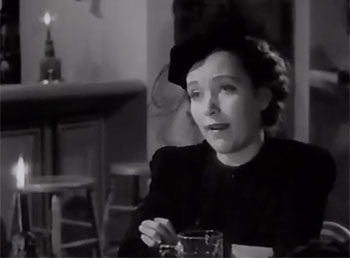
Above: Kirk Alyn tries to fight off a highly unusual adversary. Above: Maxine Doyle as the short-lived but colorful Knockout Nellie.
Unlike these incidental touches, the serial’s main plot is not particularly offbeat–but is quite well-conceived; like the various capers in Federal Operator 99, Manning’s scheme for acquiring the Quantero inheritance is ambitious enough to provide an interesting basis for the action, but not too grandiose for the serial’s budget. The writers also prevent the villains’ attacks on Dolores and on the other Quantero heirs from becoming too repetitious; the murder attempts are neatly alternated with lengthy investigative forays by hero and heroine. The last of these forays, which involves an old portrait of “Don Q,” leads quite logically into the satisfying final showdown–although this otherwise excellent climatic sequence is slightly marred by forgetfulness on the writers’ part (in re the number of surviving Quantero descendants). Aside from this error, the only other plotting misstep in Don Q is the gold-train robbery sequence in Chapter Four–which is rather awkwardly shoehorned into the narrative in order to allow for the (seamless) insertion of stock footage from The Masked Marvel.
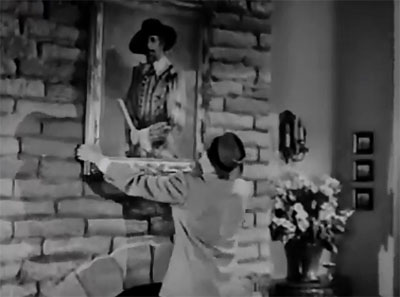
Above: Roy Barcroft purloins a portrait of “Don Q” (the model for the painting was none other than director Spencer Bennet).
However, the bulk of Don Q’s action sequences are composed of original footage–and are quite good. The fight sequences are a little less elaborate than those in Republic’s wartime serials, but just as energetically destructive; at this point in the studio’s history, serial budgets were still big enough to permit the smashing of numerous props. Spencer Bennet and Fred Brannon oversee these set-destroying brawls, with their usual chief stuntmen Tom Steele and Dale Van Sickel leading the fight team; Van Sickel stands in for hero Kirk Alyn in the serial’s first fight scene, with Tom Steele doubling villain Roy Barcroft, but their “roles” are reversed in all subsequent scenes–fortunately, since the physical differences between the lanky Steele and the chunky Barcroft are hard to overlook (as one of my regular readers, “Old Serial Fan,” has pointed out in his comment on another review).

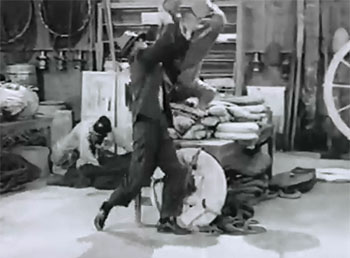
Above left: Helen Thurston (doubling Lorna Gray) hurls a jar at Dale Van Sickel (doubling Roy Barcroft); Bud Wolfe is ducking in the corner. Above right: Tom Steele (doubling Kirk Alyn) tosses Van Sickel through the air in another fight in the same prop-filled location (a marine-supply warehouse), with Bud Wolfe again in the background. Both scenes are from Chapter Two.
Stuntmen Bud Wolfe, Fred Graham, Eddie Parker, Joe Yrigoyen, Buddy Roosevelt, Ken Terrell, Ted Mapes, and Johnny Daheim are all on hand as well; stuntwoman Helen Thurston also figures prominently in many of Don Q’s action scenes, doubling for leading lady Lorna Gray–whose character Dolores Quantero is supposed to be an expert practitioner of jiu-jitsu. The various scenes in which the plucky Dolores displays this expertise are staged quite convincingly by Thurston, her male counterparts, and the directors–unlike the similar sequences in The Tiger Woman, in which the title character most unbelievably tossed husky henchmen around like rag dolls. Here, our heroine uses jiu-jitsu to unbalance unwary thugs (and, on one occasion, a police inspector), not hurl them through the air–and never seriously does damage to the audience’s suspension of disbelief or the laws of physics.

Above: Lorna Gray (undoubled here) flings a surprised Roy Barcroft (doubled by Van Sickel) towards the floor.
Among the individual action highlights in Don Q are the pair of battles (one short, one lengthy) in the marine-supply warehouse in Chapter Two (see above), the Chapter Three antique-shop fight, the Chapter Six chemical-company fight, the Chapter Nine café brawl, the excellent fight in the laboratory/barn in Chapter Ten, the wild Chapter Eleven combat at the artist’s studio (which features the previously-mentioned armored henchman), and the fistfight in the final chapter–which, like the one in Chapter Three, is set in Manning’s antique shop, and makes novel and entertaining use of the archaic weapons one would expect to find in such a setting. Far less reliant on the prop department, but no less memorable, are the extremely well-shot fight on the fire escape in Chapter Two and the three-way grapple in a speeding car featured in Chapter Three.


Above left: Van Sickel makes an impressive leap onto Steele during the café fight. Above right: A good up-angle shot of the fire-escape fight.
The climactic battle atop a frighteningly high bridge is another standout, with hero and villain shooting it out and then slugging it out, as a crate containing the heroine teeters precariously on the bridge rail. Bennet and Brannon also stage many good action sequences that don’t rely on fisticuffs at all–among them the Chapter Five shootout on the road, the car chase that follows it, the shootout at the mine in Chapter Seven, the gun battle at the café in Chapter Nine (which features some good camera angles), and the foot chase through the grounds of the Quantero hacienda in Chapter Eleven. The shootout in the hills in Chapter Ten is memorable as well, thanks to the heroine’s use of a bow and arrow instead of a conventional revolver (the hills in question are those of Iverson’s Ranch, Republic’s usual outdoor location, which figures in several other of Don Q’s scenes).
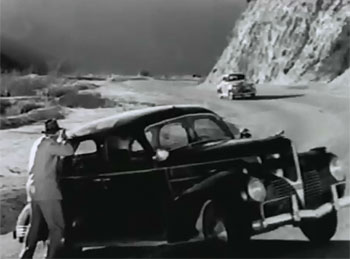

Above right: Roy Barcroft prepares to ambush the good guys’ car on the road. Above left: Kirk Alyn (behind bar) and Roy Barcroft (peering through window) shoot it out in the café in Chapter Nine.
Several of Don Q’s cliffhanger scenes rely on stock footage from earlier serials–including the above-mentioned Masked Marvel sequence, the truck crash from King of the Mounties, and the striking but familiar paint-factory explosion from G-Men vs. the Black Dragon. These sequences are all incorporated smoothly with the new footage; only the exploding building scene that ends Chapter Ten jars; though the building supposedly blown up is the familiar Republic barn (seen in medium shots in the new footage), the explosion stock footage used (from The Purple Monster Strikes) features the destruction of a different building. Since Republic had footage on hand of the barn going boom, one wonders why it wasn’t used here instead; such an editing mistake is quite uncharacteristic of the studio’s production team.
Many of Don Q’s non-stock cliffhangers are terrific; the knife-throwing sequence that ends Chapter Three is particularly memorable, with heroine Dolores (who’s gone undercover as the assistant of a nightclub knife-thrower) being menaced by the murderous Donovan, who’s taken the place of her co-star in order to terminate the knife-throwing act with a fatal “accident;” this sequence is exceedingly well-handled, with good editing, scoring, and wordless acting (on the part of Lorna Gray and Roy Barcroft, both of whom are masked and silent during the scene) making it memorably tense. The ending to Chapter Five, with hero and heroine driving off a cliff when their car is enveloped by a truck tarp released by the fleeing Donovan, is also well-done; the whale-gun scene (Chapter Two), the heroine’s dangle from the curtain of a tenth-story window (Chapter Eight), and the “glass guillotine” sequence (Chapter Eleven) make for strong episode-ending perils as well.
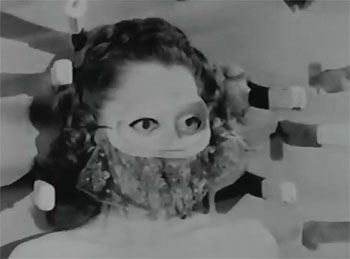
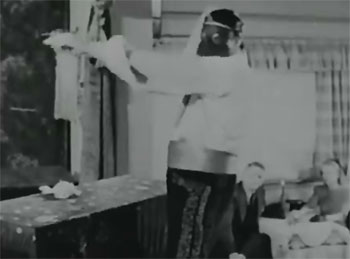
Above: Lorna Gray (left) realizes (seemingly too late) that Roy Barcroft (right) has unexpectedly taken over the leading role in the knife-throwing act at the end of Chapter Three.

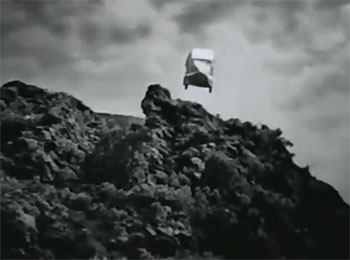
Above: Barcroft unleashes a tarp (left) that encases the good guys’ car and sends it flying off a cliff (right) to end Chapter Five.
Lovely Lorna Gray, making her final serial appearance before moving up the ladder at Republic as feature-film actress “Adrian Booth” (the name she’s billed under here), is excellent in the serial’s title role. She makes her Dolores seem far more upset about the villains’ evildoing than the typical post-war serial heroine–fittingly, considering her character’s blood connection to said villains’ victims; she comes off as passionately indignant when trying to convince the skeptical police of a deliberate plot against the Quantero family or when defying the heavies. Gray’s performance is far from unrelievedly serious, however; her jaunty enthusiasm as she prepares to face danger and her cheerful exchanges of banter with leading man Kirk Alyn balance out her more intense moments. She also does an excellent job of silently registering alarm and concern even in non-dialogue scenes, such as the knife-throwing sequence mentioned above.

Above: Lorna Gray spots an off-camera burglar in a mirror.
Kirk Alyn, as the rather flippant reporter hero, plays perfectly off Gray’s frequently fiery heroine; he conveys shrewdness, a sly wit, and even an amount of (justified) cockiness throughout the serial, bringing a welcome lightness to the proceedings without ever seeming anything less than a dependable and highly capable amateur detective. In many ways, his characterization here prefigures his two later turns as Superman/Clark Kent, in its combination of standard-issue serial heroism with somewhat more uncharacteristic wisecracking humor.
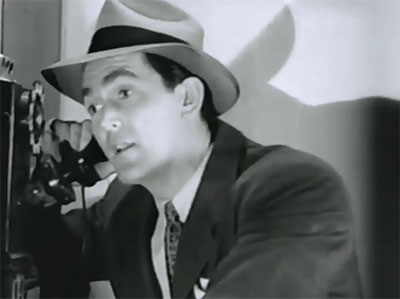
Above: Kirk Alyn phones in some information.
As Donovan, Roy Barcroft turns in the most menacing of all his many fine post-war serial henchman characterizations; while most of the secondary heavies Barcroft played were either comically thick-witted or gruffly pragmatic, he gives Donovan a smug, gloatingly cruel edge that recalls his portrayals of arch-villains like Captain Mephisto. The brusque impatience with which he dismisses his boss’s talk of land grants in order to get down to the “business” of killing the Quantero heirs, the smirking coolness with which he demonstrates his knife-throwing prowess in one chapter, and the subdued but palpable glee with which he threatens the good guys all make his character come off as extremely threatening.

Above: Roy Barcroft prepares to slug someone.
Brains heavy LeRoy Mason has far less to do than Barcroft, but handles his role with his usual skill–suavely and dignifiedly assuring the protagonists that he’s on their side in their hunt for Donovan, harshly and grimly issuing orders to Barcroft, expounding on his landowning ambitions with a sort of controlled fervor, and making sarcastic remarks with off-handed flair (like his amusing comment about modern artists).
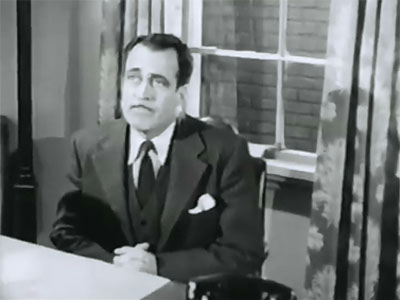
Above: LeRoy Mason outlines his plans.
Kernan Cripps, as the grumpy police inspector Grogan, receives more screen time (and is given more opportunities to display an individual personality) than several other background authority figures in Republic serials; his grumpy and frequently antagonistic attitude towards the hero and heroine makes his periodic appearances lively and enjoyable; it’s particularly novel to see a Republic policeman actually cautioning a Republic hero about gunning villains down too often (as Cripps does to Alyn in one chapter). Claire Meade, as Dolores’ upright and fastidious aunt, is also given more of a distinctive character type to work with than many Republic supporting players, although her screen time is much more limited than Cripps’ is.
Jimmy Ames is likable as a buoyant and helpful nightclub owner, while Frederick Howard is mild-mannered but dignified as a doomed Quantero descendant. Perennial Republic bit player Jack O’Shea plays another Quantero heir, Virginia Carroll makes a brief appearance as a female ally of the heavies, Charles Sullivan is a cop, and Tom Quinn a crooked scientist. Bob Wilke and George Chesebro have non-speaking thug bits, and I. Stanford Jolley pops up as a villainous lip-reader; Maxine Doyle, the leading lady of the serial SOS Coast Guard and the wife of former serial director William Witney, is delightful in an extended cameo as a hard-boiled moll named Knockout Nellie. The rest of Don Q’s supporting cast consists largely of stuntmen: Eddie Parker plays a minor but noticeable role throughout as LeRoy Mason’s clerk, while the rugged-looking Johnny Daheim is somewhat miscast as a villainous artist/antique collector. Most of the serial’s other stunt-team members all pop up in at least one heavy role–frequently three or four, in the case of Buddy Roosevelt, Tom Steele, and Dale Van Sickel (the latter also appears as a policeman).
Daughter of Don Q has never been one of Republic’s most famous serials, but it’s thoroughly enjoyable all the same; though different in tone from the earlier Federal Operator 99 and the later G-Men Never Forget, it resembles them both in the stylish, creative, and highly entertaining way in which it embellishes its simple crime-story plotline.

Above, left to right: Kernan Cripps, Kirk Alyn, Claire Meade, and Lorna Gray gathered around the coveted “Don Q” land grant in the serial’s final scene.
Acknowledgements: My special thanks to Files reader and commenter Michael Litant, for providing me with a digital copy of Daughter of Don Q wherewith to illustrate the above review.

Jerry, I can’t believe you omitted the in joke in chapter three where a mug shot of Barcoft is shown, and his number is 39 0 13. Anyway, it is great to see you back posting reviews.
Hi Jerry, my name is Bill Russell and I am a former columnist with Boyd Magers’ WESTERN CLIPPINGS; I also published WESTERN REVUE for many years. I enjoy very much your reviewes of the serials, especially enjoyed your wonderful comment and review of ZORRO RIDES AGAIN, my all-time favoite serial. I saw it when it first came out in ’37-38.
I’m currently writing a novel based on the serial where I use as much dialog as possible.
At the end I will do a wrap-up of the serial, and I’m wondering if I can quote you on some and much of your commentary.
Also if I could use some of the images you have in your review. I will of course attribute you for your work.
Please let me know if that will be o.k. When it is completed and published and will send you a copy.
Just provide your address when appropriate.
Thanks much,
Bill Russell
Maitland, FL
If you know Boyd Magers, you can always check with him as to my background.
Thanks very much for your kind words, Mr. Russell; you’re welcome to use any material from my Zorro Rides Again review that you need. I’ll send you my address via e-mail.
I got a kick out of that myself..maybe the DOC didn’t retire Harry’s number. I couldn’t believe the advertising in Spy smasher with two serials on a billboard that hid the path to the bad guy’s place. Also mighty glad to see “The Return of Jerry Blake”.
Mike, Republic did that gag several times. In Carol Landis’s first scene in DAREDEVILS OF THE RED CIRCLE, right behind her is a one sheet for THE LONE RANGER RIDES AGAIN.
Well that is funny, a good gag is worth repeating I guess. I used to wonder if 39013 meant something to someone in the crew and that’s why they chose it more than once.
Thanks for the comments, guys; it felt good to post a review again, although I probably won’t get around to posting any more new ones until after Labor Day. I opted not to mention the prison-number in-joke in the review simply because it always seems to be referred to in other reviews of the serial, and I wanted to touch on some of the serial’s less frequently-mentioned quirks. However, it is indeed a nifty in-joke; interestingly, none of Don Q’s writers worked on Daredevils of the Red Circle, leading me to the conclusion that the “39-0-13” reference was the idea of Don Q’s producer Ronald Davidson–who had been one of the writers on Daredevils.
Wonderful to have you back. You have become a wise and witty writer, and it wouldn’t surprise me at all if someday you produce the best ever book on sound serials. Of course you would have to rework the kid stuff, but you know that. Anyway, best wishes.
“Daughter of Don Q” is generally enjoyable and well-acted, but as with so many of the post-war Republic outings, after a few chapters it becomes somewhat assembly line and a trifle formulaic. The short running times for the chapters certainly don’t allow for much nuance. Still, it was worth watching if only for Barcroft’s performance.
One of the better plotted and acted serials as well as some different cliffhangers. Barcroft was at his best, but his double in the fight scenes looked 30 pounds lighter. This serial may hold the record for thrown objects and Ms. Booth has to hold the record for being knocked out by said flying objects. Had to rewind several times in chapter 12 to see the box containing Ms. Booth teeter, start to fall and come back onto the bridge. Thank goodness we didn’t have stop action back when. And couldn’t the studio buy another dress for Ms. Booth? Still enjoyed it.